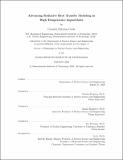Advancing radiative heat transfer modeling in high-temperature liquid-salts
Author(s)
Coyle, Carolyn Patricia.
Download1227100907-MIT.pdf (36.23Mb)
Other Contributors
Massachusetts Institute of Technology. Department of Nuclear Science and Engineering.
Advisor
Charles Forsberg and Emilio Baglietto.
Terms of use
Metadata
Show full item recordAbstract
Nuclear and solar-thermal communities are investigating the use of high Prandtl number liquid-salts in energy generation systems, including fluoride salt-cooled high-temperature reactors (FHRs), molten salt reactors (MSRs), fusion devices, and concentrated solar power plants. The temperature distribution in the coolant salts can be affected by participating media radiative heat transfer, due to the high temperature operation and their semitransparent nature. Computational fluid dynamics (CFD) becomes a valuable tool to model the complex 3-dimensional nature of the heat transfer, especially in regions where temperature-dependent material corrosion drives the need for accurate local temperature predictions. Correctly modeling radiative heat transfer in CFD requires well-characterized liquid-salt optical properties, which are not yet known. Additionally, current CFD approaches can become computationally too expensive for practical use when spectral effects need to be resolved. A lower cost approach, capable of still resolving the coupled convective-radiative heat transfer is therefore needed. In this thesis, an experimental apparatus for measuring the spectral absorption coefficients of 46.5%LiF:11.5%NaF:42%KF (FLiNaK) and 50%NaCl:50%KCl is designed and validated to have high-measurement accuracy in the transmissive and multiphonon absorption regions where radiative emissions peak. A high-fidelity CFD methodology is then developed to model participating media radiative heat transfer. The approach defines a consistent, spectral banding procedure that captures non-gray absorption behavior at reasonable computational cost. The methodology is applied to CFD simulations of a twisted elliptical tube heat exchanger geometry, where local, 3-dimensional effects are especially significant. A matrix of simulation results comparing FLiNaK and 66.6%LiF:33.4%BeF2 (FLiBe) coolants provides a quantitative assessment of the thermal radiation contributions to the overall heat transfer. Laminar flows, expected in accident scenarios, experience the strongest effect, where lower average wall temperatures and enhanced temperature uniformity result in an effective Nusselt number increase of up to 11%. Turbulent flows see a reduction in maximum local wall temperatures up to 25'C, which could have a notable impact on reducing corrosion effects. The observed trends demonstrate the larger impact of radiation effects in FLiBe simulations due to larger absorption in BeF2. This suggests thermal radiation may be more dominant in MSRs, where dissolved fuel and impurities increase absorption. The method proposed to include the effects of thermal radiation in CFD analysis can support a more effective and accurate design of high temperature systems and components, providing increased safety margins for operation.
Description
Thesis: Ph. D., Massachusetts Institute of Technology, Department of Nuclear Science and Engineering, September, 2020 Cataloged from student-submitted PDF version of thesis. Includes bibliographical references (pages 125-133).
Date issued
2020Department
Massachusetts Institute of Technology. Department of Nuclear Science and EngineeringPublisher
Massachusetts Institute of Technology
Keywords
Nuclear Science and Engineering.